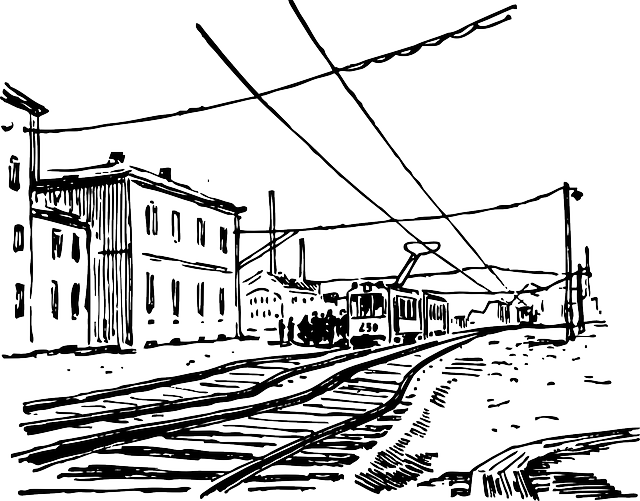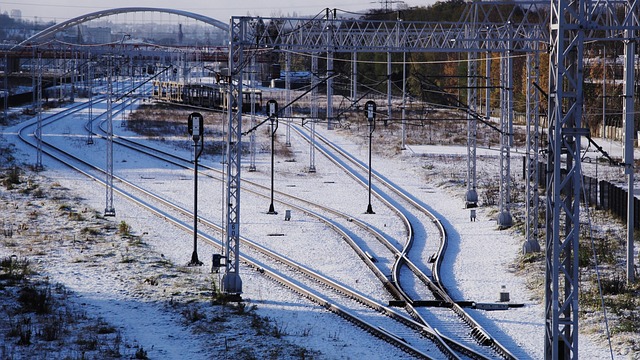In the 19th century, Oregon's railroad expansion transformed Lane County into a bustling hub of economic growth and cultural exchange. The construction of iron thoroughfares connected remote communities, facilitated trade, and attracted settlers, businesses, and infrastructure. Lane County's strategic location played a significant role in its development as a thriving rail center. Today, visitors can explore historic sites and attractions that highlight the county's rich railroad history, while former rail corridors are being repurposed for modern sustainable transportation.
“Unveiling the Tracks of Time: Exploring Lane County, Oregon’s Railroad Heritage
Lane County, nestled in the heart of Oregon, boasts a rich historical narrative centered around its bustling railroad industry. This article delves into the transformative journey of railroads in the region, spanning from the early emergences to the modern era. We examine Oregon’s expansive rail network and its profound impact on Lane County’s socio-economic landscape. Discover how key players shaped the county’s railway destiny, and explore the cultural significance of railroad towns that flourished along these historic routes.”
- The Emergence of Railroads in Lane County: A Historical Overview
- Oregon Railroad Expansion: Driving Forces and Impact on Lane County
- Key Players and Companies Shaping Lane County's Rail Network
- Railroad Towns Flourish: Socio-Economic Impact and Cultural Significance
- The Decline and Adaptation: Modernization and Legacy of Lane County's Rail Industry
The Emergence of Railroads in Lane County: A Historical Overview

In the mid-19th century, as Oregon’s population grew and demand for transportation increased, railroads emerged as a transformative force in Lane County. The construction of these iron thoroughfares connected remote communities, fostering economic growth and facilitating the exchange of goods and people. The Oregon Railroad expansion, driven by visionaries and entrepreneurs, laid the groundwork for what would become a bustling rail industry in Lane County.
Early railroad towns sprang up along the proposed routes, attracting settlers and businesses alike. These settlements became hubs of activity, offering services to travelers and supporting the burgeoning rail infrastructure. Lane County’s strategic location along major corridors made it an ideal spot for development, contributing significantly to its economic and cultural landscape.
Oregon Railroad Expansion: Driving Forces and Impact on Lane County

Oregon’s railroad expansion played a pivotal role in shaping the history of Lane County, transforming it into a thriving center for rail transportation and commerce. The late 19th century witnessed an influx of railroads, driven by the state’s rich natural resources and strategic geographical location. This period marked a game-changer for local economies, as rail lines connected remote areas, facilitating the transport of agricultural products, timber, and minerals to market. Lane County, with its fertile valleys and scenic landscapes, became a prime destination for railroad development.
The expansion had a profound impact on the region’s towns and communities. Railroad towns in Lane County flourished, becoming hubs for trade and social interaction. The construction of rail lines spurred population growth, attracted new businesses, and fostered a sense of connectivity across the county. Today, remnants of these historic railroads can still be seen, leaving behind a rich legacy that highlights the critical role they played in the development and progress of Lane County’s rail industry.
Key Players and Companies Shaping Lane County's Rail Network

Lane County’s rich railroad history is woven with the tales of key players and companies that shaped its network over time. The late 19th century saw a surge in Oregon railroad expansion, driven by visionaries like E.J. Corette, who played a pivotal role in establishing many of the region’s central railroads. Companies like the Southern Pacific Railroad and Oregon Railway & Navigation Company (OR&N) became powerful forces, connecting Lane County to broader networks and fostering the growth of railroad towns across the county.
These entities not only facilitated transportation and commerce but also left an indelible mark on the landscape. They built stations, fostered communities, and contributed to the economic development of Lane County, leaving a legacy that continues to resonate in the region’s historic sites and charming train-related attractions today.
Railroad Towns Flourish: Socio-Economic Impact and Cultural Significance

In the late 19th century, the Lane County railroad history was marked by a period of significant growth and transformation as Oregon railroad expansion reached new heights. The arrival of railroads brought about a flourishing of railroad towns in Lane County, sparking a socio-economic surge that forever changed the region. These rail lines not only facilitated the transportation of goods and people but also served as catalysts for cultural exchange and community development. The dense network of railroads in Lane County fostered the growth of bustling towns, each with its unique character and contributions to the local economy.
The Oregon railroad industry’s development had a profound impact on the social fabric of these communities. Railroad towns in Lane County became vibrant hubs where diverse individuals from different walks of life converged, contributing to a rich cultural tapestry. The influx of workers, entrepreneurs, and settlers led to the establishment of diverse businesses, schools, churches, and social organizations, each playing a vital role in shaping the region’s identity. This period of railroad dominance left an indelible mark on Lane County’s history, with remnants of these towns still visible today, serving as a testament to the transformative power of rail infrastructure.
The Decline and Adaptation: Modernization and Legacy of Lane County's Rail Industry

In the late 19th and early 20th centuries, Lane County experienced a significant boom in its railroad industry, fueled by Oregon’s expansive agricultural and natural resource sectors. Railroads became vital arteries connecting remote areas of the county to larger markets, facilitating the transport of goods such as lumber, wheat, and sheep. This period saw the construction of numerous rail lines crisscrossing the region, linking rural communities with burgeoning urban centers like Eugene and Corvallis. However, by mid-20th century, the landscape of Lane County’s rail industry began to shift dramatically due to modernization and changing economic realities. The rise of highway transport and the decline in agricultural production took a toll on railroads, leading to the closure or abandonment of many lines.
Despite these challenges, the legacy of Lane County’s rail industry persists. Many historic railroad towns still bear the marks of their past prominence, with remnants of railway infrastructure and buildings serving as reminders of an era that shaped the county’s identity. Today, efforts are underway to adapt and reuse former rail corridors for new purposes, such as trail systems and light rail transit, reflecting a modern approach to sustainable transportation that pays homage to Lane County’s rich railroad history. These initiatives not only preserve local heritage but also position the region for future economic and environmental prosperity.
